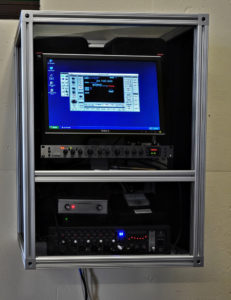MUSIC OF THE SPHERES is a permanent site-specific sound-art installation in the department of Physics of the University at Buffalo and has been constructed with funds provided by the Robert G. and Carol Morris Grant for Artistic Expression in Visual Arts.
The Pythagoreans maintained that the distances between the planets had exactly the same ratios as would produce harmonious sounds in a plucked string. To them, the solar system consisted of ten transparent celestial spheres revolving in circles about a central fire, each sphere giving off a sound the way a speeding projectile makes a sound as it passes through the air; the closer spheres gave lower tones, while the farther outer ones moved faster and gave higher pitched sounds. All combined into a beautiful harmony they called “the music of the spheres.”
This idea was adopted by Plato, who in the Republic stated that; “…Upon each of its circles stood a siren who was carried round with its movements, uttering the concords of a single scale,” and in the Timaeus, described the circles of heaven as subdivided according to harmonic musical ratios.
Johannes Kepler, 20 centuries later, wrote in the Harmonice Munde (1619) that he wished to explicate “the magnificent edifice of the harmonic system of the musical scale … as God, the Creator Himself, has expressed it in harmonizing the heavenly motions … I grant you that no sounds are given forth, but I affirm … that the movements of the planets are modulated according to harmonic proportions.”
“The Music of the Spheres” is a sound-art installation that takes the Pythagorean / Platonic notion of celestial music at its literal word and by using contemporary technology, presents the viewer / listener with exactly that: music that emanates in real-time from extraterrestrial sources. The emphasis of this project is the processing of real-time astronomically generated radio signals by both analog and digital electronics and the presentation of the sonic result as ambient sound events in an installation format. Because the sources are extraterrestrial and subject to various atmospheric and space-weather phenomena, the sonic result will, by nature, be highly unpredictable and is dictated as much by the caprices of nature as by any control and processing parameters predetermined by the artist.
The sounds heard emanate from three sources: The Radio Jove receiver operating on a VHF frequency of 20.1MHz, the frequency of extraterrestrial radio signals generated by massive thunderstorms on Jupiter. It has no AGC and exhibits a wide dynamic range, exceeding 30 dB. The Radio Jove is a direct conversion receiver and has a bandwidth of 7.5 kHz designed for reception of radio noise bursts from the planet Jupiter. The CME receiver is tuned to the radio spectrum of powerful solar storms associated with Coronal Mass Ejections on a VLF frequency of 40 KHz, detecting and amplifying the radio signature of any solar CME’s reaching the D Layer of the Earth’s atmosphere. The iCom receiver is a computer-controlled high quality, research grade, radio system tuned to the middle of the allocated radio astronomy UHF frequency band of 406.7 MHz – the area deep space Radio Pulsars (neutron stars) and continuum radio astronomy. The range of sonic results that this installation presents includes varied hiss, pops, sweeps of timbre, transient bursts, explosive pulses, electronic noise, tone sequences, and other sound events germane to the reception of VLF, VHF & UHF radio astronomy signals.



